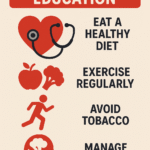
Innovative Solutions Reshaping Patient Care Post-Pandemic

Telemedicine, the use of telecommunications technology to provide healthcare services remotely, is Transforming Patient Care Today
The Evolution of Telemedicine
Telemedicine significantly impacted patients’ connection with healthcare services not long ago, particularly after the pandemic. This trend is not going away; it is a total transformation of patient care.
Why It Matters Now
- Access: Even in remote areas, fewer people can access healthcare.
- Convenience: Patients can have their appointments from their own homes, which saves not only time but also the cost of travel.
- Innovation: Medical technology creates better healthcare practices. For patients, it means getting the care they need in no time or effort. For researchers, it opens brand new doors for the study. For healthcare providers, it will be a more effective and efficient organization of their work and improve patient results. Our world is so chaotic that it is demanding more and faster. Therefore, telemedicine is no longer an option; it is the only way of living in this digital world.
Historical Context of Telemedicine
Telemedicine, as a concept, has been around for decades. However, it was the global health crisis that catapulted it into widespread use, far beyond what was previously imagined.
Evolution in Healthcare
- Before COVID-19, There had been only minor use in the healthcare system, and it was not relied upon much for rural care.
- Post-Pandemic Surge: Its popularity came about due to a fast transition to virtual visits—doctors and patients were suddenly communicating through screens.
Impact on Medicine and Public Health
- Accessibility Revolution: It is now possible for patients to have a more in thought approach while they are being treated. The geographic barrier is broken through telemedicine location services, which enhance patient access by providing more personalized care.
- Efficiency Gains: Lowers waiting time and fast-tracks the diagnostic process.
- Convenience Factor: Patients move from traditional healthcare settings to online consultations, which are also more convenient. In other words, telemedicine is not only a trend; it is a game-changer changing the face of healthcare.
Telemedicine: A Game Changer in Healthcare
Current Innovations
Telemedicine is not just a trend but a revolution! During transitions to the new everyday world, these innovations are crucial.
- AI-Driven Diagnostics: Feature of a time when 70% of doctors use AI software for faster diagnosis.
- Remote Monitoring: Patients use more than 30% of wearables to keep track of health metrics.
Patient Engagement
The discoveries post-pandemic brought to the foreground solutions that were built around patients, among other things:
- Increased Accessibility: Hyperlinks to virtual visits facilitate healthcare services within reach at every time and place.
- Cost-Efficiency: Telehealth visits significantly lower healthcare costs by close to 50%. These changes are not just about the benefits of medical outcomes; they also foster individuals. Thus, healthcare becomes more personal and instantaneous.
Impact on Patients and Families
Telemedicine is restructuring healthcare, as it is now more included and time-saving. This is the way the technology benefits the public at large:
- Convenience is Key: The old days of hanging out at the doctor’s office for hours at a time are over; now, you can have video visits at home.
- Expanded Access: People in remote locations can have a virtual appointment with a specialist, and the process is not as complicated as before.
Improvements in Treatments and Quality of Life
Telemedicine is not just about talking; it’s about real change.
- Mental Health Matters: Virtual therapy decreases the degree of bad attitudes, leading to seeking crucial support.
- Chronic Care Made Easy: Through regular visits with your health care provider, you can control the condition to stay in good general health. “I had an opportunity to contact a doctor without the hassle of commuting. It really made a difference in my life!” This is the telemedicine experience of most people, in a nutshell. In a world where healthcare is easy, telemedicine makes it a reality.
Impact of Telemedicine on Healthcare Professionals
Challenges We Face
Telemedicine is a game-changer and the best one we have, but it also has challenges. Several healthcare providers are grappling with the following:
- Training: Getting used to and using new technologies is such a long process that it often takes time and effort.
- Cost: Unfamiliarity with how it works can be intimidating for small practices with high upfront costs.
- Implementation: Linking telemedicine services into the current system is a challenging task.
Opportunities for Growth
But then again, the transformation of telemedicine opens the doors for the out-turn of very many advancements:
- Efficient Resource Management: The reinvented procedures offer optimal use of time and the workforce.
- Enhanced Patient Care: Probable side effects without adequate access to medical treatments mean patient outcomes will likely improve. Adaptation to these is a society’s only future and must-have characteristic. Adapt or fall behind.
The Telemedicine Evolution: Transforming Healthcare
Key Benefits
Telemedicine is changing the face of healthcare, responding to the need for efficiency, accessibility, and better patient outcomes.
- Convenience: The patients can talk to the doctors from their homes transiently, saving travel time.
- Wider Access: The remote and poor parts of the country have unprecedented access to the super-specialists.
- Cost Effectiveness: It cuts fixed costs to the minimum, making it possible for healthcare givers to transfer these savings directly to the patients. Facts reveal that telemedicine can reduce no-shows by appointment to 50%. The patients are more involved with their health issues to the extent that they are the main factor in better chronic disease control. It’s not hard to know that the future is getting sicker, but it’s nearly impossible to think about not supporting this wave.
Challenges in Telemedicine
Patient Perspectives
- Access Issues: Everyone Does Not Have A Reliable Internet Connection. This is [Thus] to some extent where hurtles are created.
- Privacy Concerns: What about the privacy of personal health data shared online? Is it worth the gamble?
Researcher Insights
- Data Validity: How can we be sure of the accuracy of remote diagnoses? The quality of virtual consultations is being questioned.
- Generational Divide: Certain people find adapting to the technology complex. Not all oldsters are good at dealing with technology like new ones are.
Regulator Challenges
- Lack of Standardization: Different states have different laws. Consequently, patients are confused because of this inconsistency.
- Liability Questions: Whose should be responsible for the downsides of the virtual setting? It is an open road problem. The issue of ethics is still current amid changes in telemedicine. It is essential to resolve these issues while moving forward.
Develop and Manage Telemedicine Services in Healthcare Facilities
Trends in the Healthcare Community with Telemedicine
Telemedicine is the talk of the town in the healthcare industry, and you can easily access and participate. Here’s how:
- Download Telehealth Apps: Begin using recognizable apps allowing video visits. The apps are easy to navigate and usually are supplemented by reminders.
- Schedule Virtual Visits: Arrange appointments that fit into your daily lives. No longer the waiting rooms; one click, you are right where your physician is.
- Prepare Your Space: Look for a quiet place. This will help you concentrate and feel more at ease when consulted.
- Stay Informed: Be on top of online resources. Getting to know telemedicine will allow you to put the proper questions to the right people. Telemedicine is transforming the landscape of healthcare delivery; become a part of this change!
Telemedicine Revolution: Molding The Way Patients Will Experience Healthcare In The Future
Cutting Edge Solutions To Come
Telemedicine is nothing but a fad; it holds the future. As medicine is transforming, major outings are on the way:
- AI Diagnostics: Picture a planet with AI foreseeing health problems before they surface and producing treatment plans instantly.
- Remote Monitoring Tech: The latest wearable devices will make patients their health supervisors from anywhere due to their mobility and reliability.
- Virtual Reality Therapies: Picture mental health treatment that involves captivating experiences, such as VR, for addressing mental health issues.
Career Opportunities in Biotech
The biotech sector is a treasure trove of new opportunities, ordinarily undetectable in the past. Here’s what to look forward to:
- Health Data Analysts: Telemedicine expansion has made diagnostics more complicated. Medical exams require more skilled experts to interpret vast amounts of patient data.
- Telehealth Coordinators: These roles bridge technology and patient care, ensuring seamless service and increasing patient satisfaction.
- AI Healthcare Developers: When these talented developers introduce application programming interfaces (APIs) and technologies that give health software a modern touch, patient and intelligent doctor interaction will be born. AI team will train the innovative generation that designs the future tools, creating new dialogue and interaction with the patients being revolutionized). In this luminous visible event, engaging with health tech means making healthcare more accessible, personalized, and exciting. Are you ready to dive in?
Key Takeaways on Telemedicine Evolution
Navigating the Changing Healthcare Landscape
Similar to the past, when we experienced artificial intelligence (AI) and machine learning (ML), these are now pervasive in various industries. The telemedicine revolution represents a significant change from traditional medicine. It is a new era where essential technologies will be developed to optimize patient-doctor cooperation. The changes we are getting used to nowadays due to the COVID crisis are beyond urgent. We are staring at the disruption of major industries like schedule optimization, equipment maintenance, data utilization, and self-diagnosis
- Convenience is Key: Virtual consultations will be the quick fix of the century. They provide easy and convenient access to healthcare for patients and are even a time-saving solution.
- Tech-Savvy Solutions: It’s great to see these new technologies. More importantly, they help patients engage and receive care much more effectively and can also be a real relief to them.
- Health Equity: Besides, thousands of miles of distance cannot limit doctors’ ability to get to patients through telemedicine. Remote care systems are the best for those living in remote areas where it is difficult to access healthcare services. Staying ahead of the curve is unthinkable. It is pivotal to embrace these trends now. Act Now: Connect with a telemedicine specialist to learn more.












Post Comment